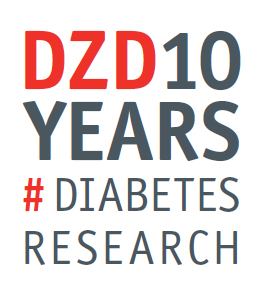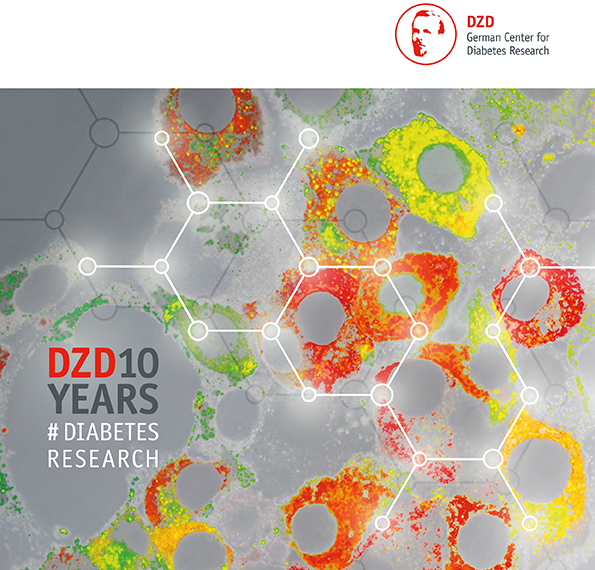10 Years DZD
The German Center for Diabetes Research (DZD) was founded on June 24, 2009. It was the second of six German Centers for Health Research (DZG) established on the initiative of the German Federal Ministry of Education and Research.
More than 400 experts from various disciplines such as basic research, epidemiology, health care research and clinics work together in the DZD on new stratified prevention and therapy concepts. Their goal is to bring the results of research from the laboratory to the patient as quickly as possible (translation) in order to better prevent and treat diabetes and thus avoid secondary diseases.
In the ten years of its existence, the DZD has made a name for itself nationally and internationally. This makes it an attractive training center for young scientists in translational diabetes research.
RESEARCH SPOTLIGHTS
The research work of the DZD not only helps to better understand the pathogenesis of diabetes, but also lays important foundations for innovative prevention and treatment procedures.
Here the standings at the 10th anniversary in 2019. Some findings and developments have since progressed further.
# Determine your own diabetes risk
The DIfE – German Diabetes Risk Score® (DRS) (drs.dife.de) provides important information on the individual diabetes risk. With the help of the DRS, adults can determine their personal risk of developing type 2 diabetes within the next five years. In addition, the online test also provides individual ways of reducing the risk – for example by making lifestyle changes.
Diabetes Research and Clinical Practice 2014
Update: The prediction period of the DIfE - GERMAN DIABETES RISK SCORE® has now been extended to ten years. The test has also been expanded to include a tool for predicting the risk of cardiovascular disease. Further information
# Immunotherapy for type 1 diabetes
Auto-immune disease type 1 diabetes usually begins with a misdirected immune reaction against insulin. DZD experts are working on a kind of desensitization to prevent the outbreak of the disease in children with an increased genetic risk. A daily dose of insulin powder trains the body to tolerate its own insulin. The procedure is currently being tested in the randomized, controlled double-blind POInT study.
JAMA 2013 | Nature Communications 2016
# Biomarkers for type 2 diabetes
Type 2 diabetes does not develop from one day to the next. Patients go through lengthy preliminary stages in which the metabolism begins to change. DZD researchers have been able to identify metabolites and proteins in the blood that serve as biomarkers for these processes.
Diabetologia 2016 | Diabetes 2019
# Lifestyle is inheritable
Not only the genetic code itself influences the risk of diabetes. The lifestyle can also influence the extent to which certain genes are read and their information is implemented (epigenetics) – and that even over generations. The DZD was able to show that diet-induced obesity and diabetes are even transmitted epigenetically to the offspring, both via egg cells and via sperm. An epigenetic modification promotes obesity and fatty liver disease, both of which are related to type 2 diabetes.
Nature Genetics 2016 | Diabetes 2017
# Discovery of new candidate genes for diabetes
Metabolic diseases like diabetes and obesity are a worldwide problem. In addition to lifestyle and environmental factors, many different genes are responsible for their development. The DZD has identified more than 50 new genes associated with metabolism. The genes share common regulatory elements and presumably form a network.
Nature Communications 2018 | Human Molecular Genetics 2018
# Gestational diabetes affects the fetus
Gestational diabetes affects the unborn child. DZD studies show that in gestational diabetes, the fetal brain response is slowed down after an expectant mother's meal. These children may already have insulin resistance in the brain while in the womb, which could increase the likelihood of the child developing overweight and type 2 diabetes later in life. Now DZD researchers are investigating whether this can be prevented if the expectant mothers make changes in their lifestyle.
The Journal of Clinical Endocrinology and Metabolism 2015
# "Artificial" pancreas
In type 1 diabetes and in the advanced stage of type 2 diabetes, the insulin-producing beta cells in the pancreas are destroyed. The DZD is working on an artificial pancreas in which the beta cells are surrounded by a special Teflon membrane that allows hormones and nutrients to pass unhindered but prevents contact with the body's own immune cells. The great advantage of the system is that there is no need for drugs to suppress the immune system.
PNAS 2017 | Nature Scientific Reports 2018
# Beta cells made in the lab
One research focus of the DZD is the protection and regeneration of islet cells. Important findings are provided by the DZD biobank, which is unique in the world and contains samples of human pancreas tissue. From these pancreatic islets, insulin-producing beta cells can be isolated. Further promising approaches include regenerative processes in which beta cells are generated from stem cells. DZD researchers are working to exploit these endogenous reserves and have identified the Flattop protein as a biomarker that makes it possible to distinguish between the two variants of beta cells (insulin-producing cells and proliferating reserve cells). Currently, a facility for the application-oriented production of beta cells from human pluripotent stem cells is being set up.
Nature 2016 | Diabetologia 2018
# Multihormones to combat obesity
Multihormones can open up new possibilities in the treatment of type 2 diabetes. DZD experts have developed an active ingredient that combines the effects of the three hormones GLP-1, GIP and glucagon. In the animal model, the triple hormone not only drastically reduced blood sugar levels, appetite and body fat, but also improved cholesterol levels and calorie burning and reduced fatty liver. The first active substances are already in the clinical phase. DZD researchers are currently working on further multihormones, among other things to improve glucose metabolism and cholesterol levels as well as to reduce body weight and fatty degeneration of the liver.
Science Translational Medicine 2013 | Cell 2016
Update: The first representative of this new class of drugs has meanwhile been approved in the USA and Europe for the treatment of type 2 diabetes. The drug tirzepatide reduces body weight by an average of 22 percent and is used successfully for type 2 diabetes. Further information
# The brain – mastermind of the metabolism
Studies during recent years have proven: The brain is an insulin-sensitive organ. For example, a number of brain areas respond to insulin, such as areas important for food intake, metabolism, and memory. The DZD could for example show that altered brain responses are involved in the development of whole-body insulin resistance. These findings can open up new therapeutic approaches.
Nature Neuroscience 2013 | Nature Reviews Endocrinology 2015 | Cell 2018
Update: New studies show that obesity, an unfavorable distribution of fat in the body and the development of type 2 diabetes are often associated with a reduced effect of the hormone insulin in the brain (insulin resistance). DZD studies suggest that exercise or the GLT2 inhibitor empagliflozin can be used to treat this insulin resistance in the brain.
Further information:
Diabetes Drug from the Group of SGLT2 Inhibitors normalizes Insulin Action in the Brain
Exercise Helps Against Insulin Resistance in the Brain
# Diabetes and fatty liver
About one in three adults in industrialized countries has a diseased fatty liver. This also increases the risk of developing type 2 diabetes. The accumulation of fat in the liver favors a disturbance of the blood glucose metabolism. The liver cells produce an increased amount of hepatokine fetuin-A. The protein binds to insulin receptors of muscle and fat cells and thus contributes to insulin resistance.
Research by the DZD has revealed that the three parameters fetuin A level, fatty liver status and fatty acid values in particular indicate an increased risk of diabetes. Studies show that severely overweight patients with non-alcoholic fatty liver disease have significantly increased mitochondrial activity in the liver. As the progression to fatty liver inflammation (NASH) progresses, mitochondria performance decreases and oxidative stress increases. This is due to the fact that the liver initially burns excess fat in the early stages of obesity. Even one single high-fat meal can harm the metabolism and pave the way for the development of fatty liver disease and diabetes. The DZD is starting clinical trials to investigate the effects of combined treatment for type 2 diabetes and NASH.
Nature Reviews Endocrinology 2013 | The New England journal of Medicine 2014 | Cell Metabolism 2015 | Journal of Clinical Investigation 2017 | The Lancet Diabetes & Endocrinology 2018 | Nature 2018
# Diabetes subtypes
Type 2 diabetes is a disease that manifests itself very heterogeneously. There is not "the" type 2 diabetes, but different subtypes. Studies from Scandinavia show that there are distinct subtypes that have various degrees of severity. These groups could be confirmed by the German Center for Diabetes Research (DZD) in analyses of the German Diabetes Study (DDS). Patients suffering from certain subtypes have a high risk of diabetic complications.
Type 2 diabetes does not develop from one day to the next. Patients often go through longer preliminary stages in which the metabolism already begins to change (prediabetes). Current studies by the DZD show that there are already different subgroups that react differently to lifestyle interventions. Studies indicate that not every prediabetic has the same high risk of developing diabetes later. Rather, there is a high-risk group: test persons suffering from fatty liver with insulin resistance or insulin secretion disorders are very likely to develop a manifest diabetes disease.
The Lancet Diabetes & Endocrinology 2019
Update: Subgroups of diabetes are also recognizable in children and adolescents. Further information
There are six clearly definable subtypes in the preliminary stage of diabetes, prediabetes, as well. Further information

Brochure














